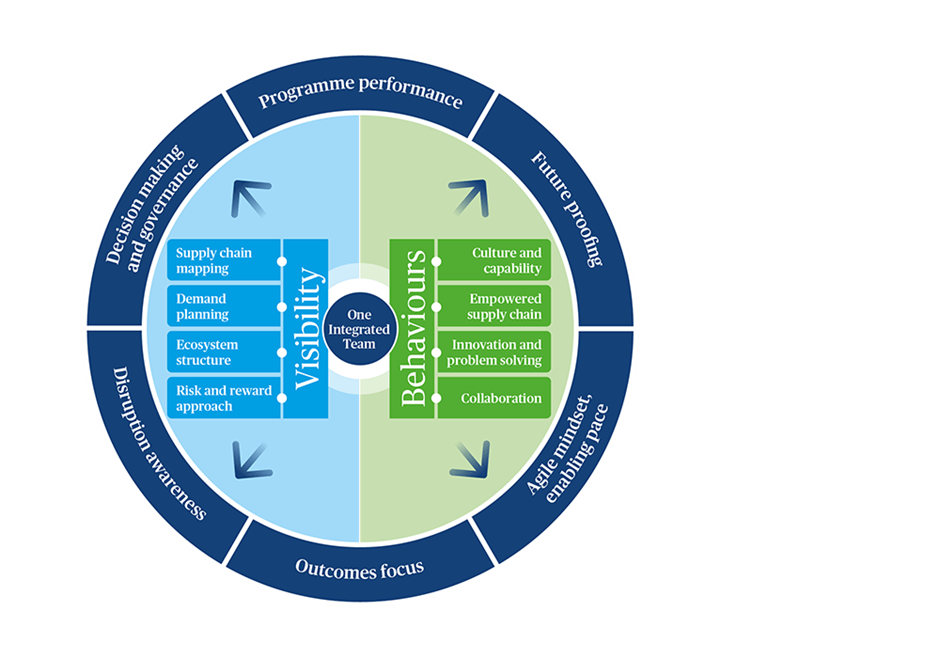Successful partnerships in defence: three brilliant basics
Defence programmes are some of the most complex and strategically important that any government delivers. Accountability, levels of responsibility and expectations are held across vast supply chains, and complexities are often exacerbated by the way responsibilities are allocated and managed. When disproportionate importance is placed on certain elements of the supply chain it can result in a lack of clarity around outcomes and intent, posing a significant challenge to successful delivery.
The National Audit Office’s (NAO) report, ‘Improving the Performance of Major Equipment Contracts’ highlights the scale of the challenges and the lack of confidence in delivery. Looking across 13 current UK Ministry of Defence (MOD) programmes, the report forecasts cumulative programme delays of 254 months in achieving entry to service since going into contract. The report talks extensively about the role of the UK MOD’s Primes / Tier 1 suppliers and their very successful introduction of a Strategic Partnering Programme, but the issue stretches further down the supply chain, and their disconnect back up into the MOD.
Delays clearly bring huge costs, and these are not only financial; they may for example also result in equipment failing to keep pace with technologies and requirements, leaving those on the front line without cutting edge capability and the risk of being outmatched. There is no easy fix to delays, the associated capability disconnects, and far wider challenges faced in the delivery of defence capability.
To address these issues across the entire supply chain, there are a few brilliant basics that can be put in place alongside a holistic and programme led approach.

1. Aligning behaviours
A lack of alignment in cultures and behaviours can lead to a breakdown or erosion of programme team relationships, process compliance and ultimately, delivery. Each part of the supply chain, including client organisations such as government defence departments, need to understand the individual accountabilities they hold, and the responsibilities they have that enable each other to undertake the work most effectively, all aligned together through common targets. This enables the whole eco-system that is charged with delivering defence capability to function more efficiently, aligned ultimately under a set of common outcomes.
People are the true drivers of innovation, delivery and excellence – if you treat suppliers and contractors as ‘outsiders’ at any stage of a project, then that approach will be reflected throughout delivery.
This also applies to internal MOD functions who often can be the greatest blocker to innovation, where their focus is more on compliance rather than outcome. This makes creating a unified and deep understanding of requirements more challenging. To address this, and drive better behaviours, the entire supply chain should be considered on equal terms when it comes to the importance of the overall success of a project. This extends to centralised functions needing to be more strongly bound into the project outcomes rather than purely focussed on process/policy-based compliance.
There are also commercial ways of driving better behaviours, including having clear and aligned incentives in place from the start, as well as focussing governance around the three primary drivers (strategy, budget and performance). Most recently, this has been demonstrated by the UK’s Infrastructure & Projects Authority (IPA) who have developed a systematic maturity review tool (Project Routemap), with clear guidance on governance and accountability, with other areas such as requirements analysis to help bolster demand planning. These mechanisms, alongside industry guidance, support behaviours and early engagement but they should not just be the primary drivers for managing supply chains.
Complex programmes need to be founded on empathy and understanding between the strategic decision makers, those delivering the work solutions, and those operating them, underlined with the right commercial incentives throughout.
This basic integrated approach focuses on sharing and collectively managing methodology and risk, rather than just pushing it down through the supply chain and expecting everything to work out at the end.
2. Programme visibility
Every complex programme requires an extensive ecosystem to integrate physical components to the correct digital tools. Between the complexity and volume of suppliers, too often we see cases where suppliers or organisations are not able to work with each other effectively, something highlighted by the NAO. This is often due to a lack of understanding of the role each party plays in the delivery of a complex programme.
Our experience across major programmes shows that with the appropriate early and proactive management and understanding of these teams, it can become a positive experience leading to better outcomes. This can often be more effectively achieved if the supply chain are more involved during the development phase of the programme. But this is often in conflict with procurement teams who are wanting a defined and developed programme before they procure the deliverer. An effective early supplier engagement strategy coupled with demand planning can provide a clearer understanding and alignment of requirements, risks, ownership and key outcome milestones.
To ensure successful delivery of programme outcomes, client organisations should undertake comprehensive supply chain mapping.
They should go beyond Tier 1 into sub tiers to identify supply chain opportunities, unseen vulnerabilities and dependencies (where COVID has brought supply chain fragility to the fore in many markets). This should be underpinned by scenario planning including ‘worst case’ scenarios that creates transparency of fragility or resilience challenges, to enable the removal of blockers/issues within the different tiers. Once the basic mapping is completed, performance monitoring through digital systems and data must become ‘business as usual’ to maintain visibility and enable proactive action when needed.
Through our ongoing global client engagement, we have seen a common theme that many clients do not know, nor indeed, show interest, in the supply chain below the Tier 2 contractors. This is a clear concern (especially in specialist markets), at a time when organisations are becoming increasingly dependent on these supply chains. Without fully understanding the strategies, challenges and drivers from the companies within the whole supply chain, the supply chain cannot see the roadmap that is expected of them.
Expectations, demands, and crucially, time frames, need to be made clear to everyone down into the supply chain (including long term work-banks), to enable alignment of the ongoing work throughout the supply chain. This includes each tier of contractor who should be encouraged to help achieve the long-term goals of the project with some form of aligned incentives linking them back to the outcomes. Occasionally we see crossed wires between client organisations, their primes, and the lower-level supply chain tiers, which can often result in delays/ineffective working. Subsequently, it can be the smaller companies much further down the supply chain that are at the receiving end of any backlash, no matter what their role in the project.
If visibility and understanding at a programme-level of criticality are inconsistent, there will frequently be a barrier to successful delivery which results in ineffective demand planning and low supply chain resilience.
The greater the visibility and firm commitment that can be given to a supply chain, the greater their confidence to invest in capability that will ultimately lead to savings in the longer term.
3. Client and supply chain integration
Changing the relationships between the client and across the entire supply chain to drive greater integration, can bring projects back on track with improved outcomes for all involved. The UK’s MOD have signalled this through the intent set out in the Defence Security and Industrial Strategy (DSIS); reforming the Defence and Security Public Contracts Regulations and implementing a better use of market intelligence are encouraging. Defence organisations and industry support can help enable this transformation by taking these actions:
- Ensure best practices from the outset of a programme by clients engaging all suppliers and aligning operating, commercial and governance approaches. Clients and suppliers must both manage expectations and fulfil their obligations to ensure clarity, a focus on joint outcomes and drive integrated approaches. Engaging the supply chain early in the development of project/programme outcomes will invariably support delivery and realisation of business case benefits.
- Interdependent design processes. If each client and supplier in a complex project understands their role and capability, this will create an increased understanding of how each party must operate. Suppliers must understand how they are integral, and contribute, to programme outcomes, and similarly how they must rely on their client and other suppliers to succeed.
- Digital systems must enable an unimpeded sharing of appropriate information between all parties. Systems need to transparently show the supply chain requirements at the outset, not at impending deadlines or to a selected group of users. The UK MOD’s commitment in DSIS to fusing open-source information with intelligence-based analysis of political and security contexts to create an informed picture is an important step towards this goal.
In the face of the ongoing and emerging defence and security challenges we face, the successful delivery of our enhanced and step-change capabilities is critical. These major programmes can be complex, but they don’t need to be complicated. The brilliant basics of being set-up in the right way, getting the supply chain involved earlier, behaviours and visibility, are the unsung heroes when building successful and well-integrated partnerships, as highlighted in the IPA Project Routemap, and they will be key to meeting the ambition set out in the DSIS.

